Iran
Recipes
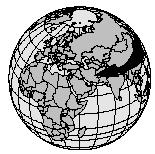
1 GEOGRAPHIC SETTING AND ENVIRONMENT
Iran is located in southwestern Asia. It covers an area of 1,648,000 square kilometers (636,296 square miles), slightly larger than the state of Alaska. Iran is geologically unstable, and experiences periodic earthquakes. In 1978, a deadly earthquake struck eastern Iran, killing at least 25,000 people.
Air and water pollution are significant problems in Iran. Twenty-five percent of the rural people do not have pure water.
2 HISTORY AND FOOD
Since the beginning of human civilization in present-day Iran, a series of peoples has invaded and conquered the region, exposing the area to new customs, beliefs, ideas, and foods, as well as bringing Iranian customs and foods back to their own home countries. The ancient Babylonians, Assyrians, Persians, Greeks, Romans, and Turks are just a few of the groups that have had an influence on Iranian culture and its cuisine.
Iranian cuisine is often referred to as "Persian." This is because, until 1934, Iran was known as Persia. The Persians are an ancient culture believed to have originated in central Asia as far back as 2000 B.C. At one time, Persian territory stretched as far east as India. Curry (a spice) was adapted from the people of India and incorporated into the Persian (now Iranian) cuisine. Modern spicy curry stews demonstrate India's influence.
The Indians also adapted foods from the Persians. When the Moghuls invaded India in 1526, they brought with them ingredients from the Persian cuisine, which they highly admired. A northern Indian cuisine called mughulai is modeled after what the Persians commonly ate: mounds of rice seasoned
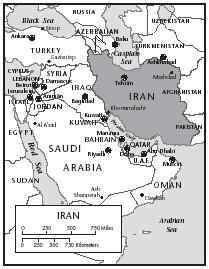
Several of Iran's most prominent dishes originated from the Greeks, Arabs, Turks, and Russians. Greece invaded present-day Iran in the A.D. 200s, introducing stuffed grape leaves. Yogurt may have originated from either Greece or Turkey, where it is also a dietary staple. The Iranian food rules that categorize foods into "hot or "cold" is believed to have been derived from ancient Greek theories of medicine (See Mealtime Customs ). Dishes made of lamb, dates, and figs were brought into the Persian diet during the Arab invasion of the 600s.
Three hundred years later, the Turks expanded their Ottoman Empire into Persian territory. The idea of stuffing leaves, vines, fruits, and vegetables with various fillings (Turkish dolma ) was reinforced by the Turks. Dolma and kofte (meatballs) have become very popular throughout the Middle Eastern countries. The kebab (cubes of skewered meat) is probably the most important introduction by the Turks—it has become one of Iran's national dishes. Strong Turkish coffee was also introduced. Once a widely consumed Iranian beverage, it has now fallen behind the popularity of chây (tea). The strong, dark tea is brewed in an urn called a samovar , a Russian word. Tea most likely originated in Russia.
Dolma (Stuffed Grape Leaves)
Ingredients
- 1 jar grape leaves (available at most Greek, Middle Eastern, and Italian markets)
- 1½ cups uncooked rice
- 1 medium onion, diced
- ¼ cup olive oil
- 2 cups water
- ½ cup fresh parsley, chopped
- 2 Tablespoons fresh dill, chopped
- 1 teaspoon fresh mint, chopped
- ¼ cup feta cheese, crumbled
- ½ cup pine nuts
- ½ cup raisins
- ½ cup lemon juice
- Salt and pepper, to taste

Procedure
- In a saucepan, sauté the onion in olive oil until light brown.
- Add rice and brown lightly.
- Add the water, salt, and pepper.
- Bring the water to a boil and simmer for 5 to 7 minutes, or until water is absorbed but rice is only partially cooked.
- Make certain rice does not stick or burn.
- Add all the ingredients except the lemon juice and mix well.
- Drain the grape leaves and place 1 Tablespoon of filling in the center of each leaf.
- Fold the sides in and roll the leaf up.
- Place stuffed leaves in a pot in even and tight rows covering the bottom of the pan. When the bottom layer is complete, start another layer. Continue rolling dolmas until all of the filling is used.
- Add ½ of the lemon juice and enough water to cover half of the rolled leaves.
- Place a plate on the top layer to hold the stuffed leaves down and to prevent them from unrolling while cooking.
- Simmer over low heat until most of the liquid is absorbed, about 45 minutes.
- Remove the plate and dolmas from the pan, drizzle with olive oil and lemon juice, and serve. May be served warm or at room temperature. Serve with Yogurt and Mint Sauce (recipe follows) if desired.
Makes about 20 to 25.
Yogurt and Mint Sauce
Ingredients
- 1 cup plain yogurt
- ¼ cup fresh mint, minced
- 1 garlic clove, minced
- Lemon wedges
Procedure
- Combine yogurt, mint, and garlic in a small bowl.
- Season to taste with salt and pepper.
Serve with Dolmas (Stuffed Grape Leaves, recipe precedes), cucumbers, or with any salad.
3 FOODS OF THE IRANIANS
Iranian food (also referred to as Persian food) is some of the most delicious and fresh in its region. It is also quite healthy, using only small amounts of red meat (usually
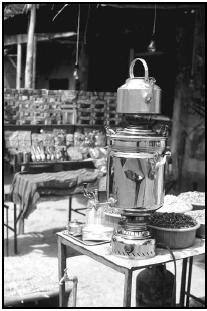
The country's cuisine is largely based on berenj (rice). It is relatively inexpensive and grown locally, making it an affordable and readily available staple in the everyday diet. A typical Iranian meal is often a heaping plate of chelo (CHEH-loh; plain, cooked rice) topped with vegetables, fish, or meat. It also provides a cool contrast to spicy meat toppings. The two national rice dishes are chelo and polo (POH-loh; rice cooked with several ingredients). There are seemingly endless varieties of dishes that can be prepared with rice in Iran.
Nân (bread), a round, flat bread that can either be baked or cooked over a bed of small stones, is the other staple food of Iranian cuisine. There are several varieties, including lavâsh , a very thin, brittle bread served for breakfast, and sangak (sahn-GAHK), a thicker, chewier variety that is usually marked by small "dimples" in the crust. Villages often make their own nân , while those who live in the city are frequently seen leaving bakeries with armfuls of freshly made loaves.
Meat, particularly chicken and lamb, is most commonly eaten as kebabs (KEE-bahbs), pieces of meat served on a skewer. Âsh (soups) and khoresh (stews) make popular entrees to most Iranian meals and often contain such meat. Abgoosht (up-GOOSHT) is a hearty soup made of mutton (sheep meat) and chickpeas. Soups are drunk directly from the bowl. Koftas (meatballs), vegetables (such as eggplant), fruits (such as quince, an apple-like fruit), and even yogurt (an Iranian mainstay) are often added to soups and stews.
Quinces, pears, grapes, dates, apricots, and Iranian melons flavored with rosewater are typically eaten for dessert. Halva (HAHL-wah, a sesame treat) and baklava (bahk-LAH-vah, crisp paper-like pastry layered with nuts and honey) are common throughout the Middle East. Iranians also love ice cream and puddings. Although sugared chây (tea) is the country's most treasured beverage and ghahvé (coffee) is highly popular, Iranians (particularly children) often enjoy a sweet drink after large meals. Palouden (PAO-loo-den), a rose- and lemon-flavored drink, dugh (sour milk or yogurt mixed with sparkling water) and fresh fruit juices can be made at home or bought in cafes and at street stalls.
Kebab Morgh (Grilled Skewered Chicken)
Ingredients
- 2 onions, finely grated
- 6 Tablespoons lemon juice
- 1½ teaspoons salt
- 2 pounds boneless chicken, cut into bite-size pieces
- 4 Tablespoons melted butter
- Small pinch of saffron threads, dissolved in 2 teaspoons warm water (optional, but recommended)
Procedure
- Mix the onion, lemon juice, and salt in a bowl.
- Add the chicken and marinate for at least 4 hours.
- Thread the chicken pieces onto metal skewers.
- Stir the melted butter and dissolved saffron into the marinade.
- Brush the marinade onto the chicken.
- Preheat broiler or grill. Grill the chicken for 10 to 15 minutes.
- Baste (occasionally moisten) and turn the chicken as needed.
Serves 8 to 10.
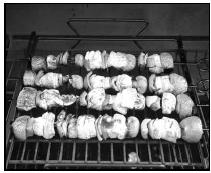
Shirazi (Cucumber and Tomato Salad)
Ingredients
- 4 medium-sized cucumbers
- 3 medium-sized tomatoes
- 1 large onion, chopped
- 1½ cups lime juice
- ½ cup olive oil
- Salt and pepper, to taste
Procedure
- Peel the cucumbers, remove the inner pulp and seeds, and chop them into bite-size pieces.
- Wash the tomatoes and chop them the same-size.
- Remove all the tomato seeds and let the excess tomato juice drain.
- Mix all the chopped ingredients together in a bowl.
- Refrigerate the mixture until you are ready to serve (no longer than 1 hour).
- Twenty minutes before serving, add the lime juice, olive oil, salt, and pepper.
- Serve in small salad bowls as a salad or side dish.
- It tastes particularly good with rice and kebabs or stews.
- Serves 4 to 6.
Halva
Ingredients
- 1 cup sugar
- ½ cup water
- ¼ cup rose water (optional)
- 4 teaspoons liquid saffron (optional, but recommended)
- 1 cup unsalted butter
- 1 cup flour
Procedure
- Boil the sugar and water together until the sugar is dissolved, then add the rose-water and saffron. Remove from the heat (but keep warm).
- Melt the butter in a pan over low heat and gradually stir in the flour to a smooth paste.
- Continue to cook over a low heat until golden in color. Slowly add the sugar and water mixture, stirring constantly. Remove from heat immediately.
- While still warm, spread onto a plate and press down with the back of a spoon, making a pattern with the spoon.
- Cut into small wedges and serve cold with toast and tea.
Serves 8 to 10.
Dugh (Sparkling Yogurt Drink)
Ingredients
- Plain yogurt
- 1 teaspoon pepper (optional)
- 2 teaspoons salt (optional)
- Dash of mint
- Seltzer water
- Ice cubes
Procedure
- Fill a tall glass halfway with the yogurt.
- Add pepper, salt, and mint; stir with a spoon.
- Continuing to stir, add enough seltzer water to fill the rest of the glass; stir well and add ice cubes.
- If a thinner drink is preferred, add more seltzer. For a thicker drink, use more yogurt.
Makes 1 serving.
4 FOOD FOR RELIGIOUS AND HOLIDAY CELEBRATIONS
Almost all (about 98 percent) of Iranians are Shi'ah Muslims. They follow Shi'ah Islam, the government religion, and celebrate Muslim holidays throughout the year. Many of the country's religious holidays celebrate the birthdays of imams (religious leaders). One such leader is the Prophet Muhammad, who is remembered each year with a celebration called Mouloud (moo-LOOD). Ashura is a day to remember the Prophet's grandson, Husayn, who was murdered in A.D. 680. On this day, parades typically crowd city streets and people give money or food to the poor if they can afford to.
Ramadan is the most sacred time of the year for Muslims. For an entire month, Muslims fast (do not eat or drink) from sunrise to sunset every day, hoping to cleanse their bodies and minds and remember those who are less fortunate. Restaurants and food stores are often closed or have limited hours during this holy month. Ramadan ends with the sighting of the new moon. The three-day festival marking Ramadan's end is known as Eid al-Fitr . During this time, the month-long fast is broken by community prayer, and then followed by a large feast with family and friends.
Now Ruz (no-ROOZ), the Iranian New Year, takes place on the first day of spring (March 21) and is probably the most important festival in Iran. Iranians of all ages eagerly await this day (literally meaning "new day"), and look forward to a new beginning and an abundance of delicious meals and sweets.
Festivities for Now Ruz begin nearly two weeks ahead of time—planting seeds, buying clothes, and cleaning homes. Haft sin (hoft-SEEN) is a tradition in which tables are decorated with seven items that symbolize triumph over evil, including sir (garlic) and senjid (olives). Samanu (sah-muh-NOO), a pudding made from flour, sugar, and walnuts, is also made at this time. For additional good luck, a mother will often eat one cooked egg for every one of her children.
Beginning on the day of Now Ruz and lasting for two weeks, feasting and visiting with friends and relatives takes place while schools and offices remain closed. Iranian sweets and snacks such as fruits, nuts, pastries, puddings, and tea, are placed on tables in anticipation of visiting guests. Iranian rice cakes and sabzi polo , a rice dish flavored with herbs, are popular foods. On the thirteenth day of the New Year, called Sizdeh Bedar (seez-DAH-bee-DAR), it is believed that homes are filled with bad luck. To help chase it away, sabzeh (wheat or lentil seeds grown during haft sin ) are thrown out the window and a picnic outdoors is enjoyed. At 5 P.M. , it is customary to eat lettuce leaves dipped in a honey and vinegar dressing, accompanied by tea.
When Iranians make their container of sabzeh , or green sprouts, for Now Ruz, they sometimes simply scatter the seeds over a plate and keep them moistened with water as they sprout and grow. They may also choose to fill a porous clay pot or jar with water and attach the seeds to the outside of the jar with strips of cloth until they stick to the moist surface. The strips are then removed and the sprouts grow upward in sunlight—green and full.
Sprouts, similar to those grown by Iranians, can be grown by filling a bowl or other container with sterile potting mix from a plant nursery, and scattering lentils or grains of barley or wheat thickly across the surface of the potting mix. The mix should be watered until it is evenly moist throughout, and then the container should be covered loosely with plastic wrap to hold in the moisture. The seeds will sprout if the container is left on a sunny windowsill; the surface should be sprinkled with water once or twice a day to keep the seeds moist.
After three days, the seeds should have begun to sprout and the plastic wrap may be removed. When the sprouts are a few inches tall, they may be tied into a bunch with a pretty ribbon, or snipped and added to a salad.
Lettuce Dipped in Honey and Vinegar Dressing
This is prepared on the thirteenth day of Now Ruz, the Iranian New Year.
Ingredients
- 1 head of lettuce
- 1 cup honey
- ½ cup vinegar, or to taste
Procedure
- Remove brown leaves from head of lettuce.
- Tear off crisp, green leaves and arrange on a large plate.
- In a bowl, combine the honey and vinegar; stir well.
- Pour dressing onto a small plate or bowl and place in the center of larger plate holding lettuce.
- To eat, dip lettuce leaves into dressing.
Shir-Berenj (Rice Pudding)
Ingredients
- 2 cups rice
- 3 cups milk
- 1 cup water
- ½ cup rose water (optional)
- ½ cup heavy cream
- Sugar or jam
Procedure
- Measure the rice into a saucepan, rinse it, and drain off the water.
- Add water and milk to rice in saucepan and cook, covered, over low heat for about 20 minutes, until rice is soft.
- Add the rose water and cook for another minute or so.
- Add the cream. Serve topped with sugar or jam.
Makes 8 servings.
Iranian Rice Cakes
Ingredients
- 2 cups rice
- 2½ cups water
- 1 cup milk
- 1 teaspoon salt
- 2 Tablespoons butter
Procedure
- Bring water and milk to a boil in a large saucepan. Stir in rice and salt.
- Simmer over low heat, covered, for about 20 minutes, then remove from heat and let stand for 10 more minutes.
-
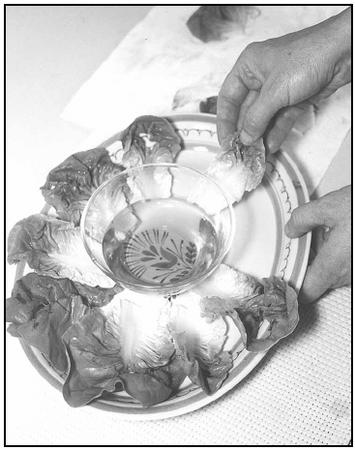 Tender lettuce leaves are arranged around a bowl of honey-vinegar dip to be served in the late afternoon of the thirteenth day of Now Ruz (New Year).EPD Photos
Tender lettuce leaves are arranged around a bowl of honey-vinegar dip to be served in the late afternoon of the thirteenth day of Now Ruz (New Year).EPD Photos - Melt the butter in a skillet and add the cooked rice, pressing down with a spatula to form a flat cake the size of the skillet.
- Cover and cook over low heat for 1 hour, flattening with the spatula every 15 minutes.
- The cake is done when it is golden brown on the bottom and the top edges are lightly browned.
- Remove the skillet from the heat and let the cake cool until it is just warm to the touch.
- Turn the skillet upside down over a platter, holding the top of the cake with your other hand. Let the cake gently slide out onto the platter.
- The rice cake may be eaten warm or cold. Cut into pie-shaped wedges to serve.
Serves 6 to 8.
5 MEALTIME CUSTOMS
Upon entering an Iranian home and removing one's shoes at the door, a gift or reciprocated dinner invitation should be offered to the host. When the meal is ready to be served, the host will place large platters of food on top of the sofreh (sof-RAY, tablecloth) that rests on top of a floor rug. Diners sit cross-legged in front of individual settings of plates, bowls, and silverware (typically a fork and a spoon). Iranians of the opposite sex (unless related) do not sit next to one another while eating. Talking is also kept to a minimum.
Although most meals will offer bread, rice, and meat (often a kebab ), Iranians often choose what foods will be served by following a set of food rules that originated from ancient Greek medicine. Foods are classified as either "hot" or "cold," depending on the food's heating or cooling effect on the individual (rather than the food's actual temperature). Hot foods include meats, sweets, and eggplant. Yogurt, cucumbers, and fish classify as cold. Iranians try to serve a balance of hot and cold foods. After dinner, chây (tea) is commonly accompanies fresh fruit for dessert, although more elaborate meals or special occasions will include pastries such as baklava or halva .
Iranians consume three meals a day, including snacks (usually nuts, seeds, fruit, or a light yogurt dish). Soph'ha'neh (breakfast), separate from the typical Iranian fare of lunch and dinner, usually consists of hot tea, cheese, and fresh baked bread from the local bakery or home kitchen. Some choose to purchase it from "bicycle breadmen" who travel from door to door, selling leftover bread for a reduced price. Northern provinces prefer asal (honey) with cooked, cold rice and fish. Central Iranians enjoy yogurt and soft cream, while southern Iranians prefer cheese and dates.
A child's weekday (Saturday through Thursday) breakfast before school is often the same as that of adults: tea, honey, bread, and feta cheese. Similar to breakfast, the light lunch served by most schools typically includes fresh fruit, dates, pistachio nuts, bread, and cheese.
Maast (Homemade Yogurt)
Ingredients
- 4 cups (approximately) milk
- 1 heaping spoonful plain yogurt
Procedure
- Scald the milk by heating it justs until it starts to boil.
- Allow it to cool until it feels warm to the touch without burning.
- Add the spoonful of yogurt and mix lightly. Place in a container with a closed lid.
- Cover with a thick cloth or towel for at least 5 hours well (to maintain warmth), or until the yogurt has thickened.
- Unwrap the container and refrigerate until ready to serve.
Makes about 8 servings.
Feta Cheese and Vegetable Tray
Ingredients
- 1 bunch green onions, sliced into 2-inch pieces
- Feta cheese, crumbled
- Spicy pickles, sliced into 1-inch long pieces
- 1 red onion, sliced
- ½ pound of sliced turkey
- Small spinach leaves
- 2 or 3 tomatoes, sliced
Procedure
- Roll up the slices of turkey.
- Arrange all the ingredients on a platter or large, circular dish.
- Serve chilled.
Makes 4 to 8 servings.
Desser Miveh (Persian Fruit Salad)
Ingredients
- 2 seedless oranges, peeled and cored
- 2 apples, peeled and cored
- 2 bananas, sliced
- 2 cups pitted dates, chopped
- 1 cup dried figs or apricots, chopped
- 1 cup orange juice
- 1 cup almonds, chopped
Procedure
- Place the fruit in serving bowl and pour the orange juice over the fruit and mix gently.
- Garnish with almonds or coconut.
- Cover and chill several hours before serving.
Makes 6 servings.
6 POLITICS, ECONOMICS, AND NUTRITION
About 6 percent of the population of Iran is classified as undernourished by the World Bank. This means they do not receive adequate nutrition in their diet. Of children under the age of five, about 16 percent are underweight, and roughly 19 percent are stunted (short for their age).
Unemployment, caused by Iran's unstable economy, helps to contribute to urban and rural poverty. Such poverty often leads to hunger and undernourishment. An absence of cooked eggs, beans, lentils, and nuts from the diet can lead to protein deficiency. Similarly, a lack of fruits and vegetables can result in an overall vitamin deficiency. Many families affected by the country's shaky economy cannot afford to purchase or grow themselves the necessary foods for a healthy diet.
7 FURTHER STUDY
Books
Greenway, Paul. Iran . 2 nd ed. Victoria, Australia: Lonely Planet Publications, 1998. Rajendra, Vijeya and Gisela Kaplan. Iran . Tarrytown, New York: Marshall Cavendish Corporation, 1996.
Sanai, Hussein, ed. Iran: The Land of Norooz . Tehran, Iran: Iran Exports Publications Co. Ltd., 1994.
Spencer, William. Iran: Land of the Peacock Throne . Tarrytown, New York: Marshall Cavendish Corporation, 1997.
Web Sites
Epicurious. [Online] Available http://www.epicurious.com (accessed April 12, 2001).
FarsiEats.com. [Online] Available http://www.farsieats.com/recipes/ (accessed April 11, 2001).
Iran. [Online] Available http://knight3.cit.ics.saitama-u.ac.jp/hobbies/iran/food.html (accessed April 10, 2001).
The Iranian. [Online] Available http://www.iranian.com (accessed April 11, 2001).
Iranian/Persian Recipes. [Online] Available http://www.ee.surrey.ac.uk/Personal/F.Mokhtarian/recipes/ (accessed April 10, 2001).
Mezzetta. [Online] Available http://www.mezzetta.com/dolmas.html (accessed April 12, 2001).
PersianOutpost.com. [Online] Available http://www.persianoutpost.com/htdocs/album/food001.html (accessed April 11, 2001).
Films
"The White Balloon." Iranian director Jafar Panahi, 1996. 85 minutes. This is a story of a seven-year-old Iranian girl named Razieh who asks her mother for money to buy a special goldfish for the Now Ruz celebration. (Goldfish in a bowl of water are traditionally placed on the table this time of year.) Eager to purchase one, Razieh travels through the city of Tehran on her journey to the pet store. As she does so, she meets people of many different cultures. The differences and similarities of people from all over the world become apparent in this charming film.
Yougurt, even the name as it is internationalized today is a Turkish food. But, what is your sources for suggesting many of Iranian food originating from foreigners as Russians (they have only been around for a 1000 years) and others like Arabs and Greeks. Who know f.ex. where Dolma was originated?
regards